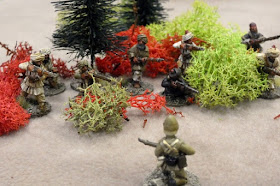I know they're a much loved set of rules (particularly, it seems across the Atlantic) but I'd never had the models or time to play. And latterly, when the model count issue was solved I've had The Men Who Would Be kings to give me a Colonial gaming fix.
However one thing that lockdown has provided is time, if not opponents, so I took the chance to give The Sword and the Flame a solo run out.
I set up the table to resemble the game in the battle report that appears in the rule book. The British patrol needs to march down the valley to secure a fort (or in my case village) risking the wrath of the local tribes.
Playing solo I split the Pathan forces into four groups (as happens in the AAR) and then used the turn of a card to decide if a particular feature held a native group when the British approached.
The 99th Humberside Patrol sets out under the command of Lieutenant Bartholomew.
A scout reveals the presence of Pathans in the brush.
Who duly give fire. Killing one man and wounding three more.
Bartholomew reorganises the column to return fire.
However he ignores his flank and more tribesmen appear.
And charge toward the British line.
Undaunted the British fire on the pathans, but with little success.
More fire from the brush wounds more British and Bartholomew orders Sgt Wiseman to continue toward the sanctuary of the native village with the wounded.
While Bartholomew orders a charge on the pathans.
However like the tribesmen before them the charge falters at the last minute and the pathans take advantage to charge Wiseman and the wounded.
Bartholomew orders his men to the rescue
The pathans in the brush pick off a couple of British stragglers.
The fight is brutal and bloody.
Initial British success sees the pathan leader cut down, but numbers tell and Wiseman flees with two remaining privates.
Bartholomew attempts to turn the tide but is himself hacked down.
The last two Britsh soldiers gather up two of the wounded and head off back down the Chamla valley.
Resounding victory to the pathans whose valley remains free of British interference for now.
So what did I think of The Sword and the Flame?
Hmmmmm, well, I'm not sure.
I didn't play the British particularly well and the luck of the draw favoured the attacking pathans. But that's about me and the roll of the dice - not the fault of the game system.
I think the primary issue for me is what sort of a game does TSatF want to be? A skirmish where every model matters? Or a small unit game - like TMWWBK?
Combat (and to a lesser extent) shooting feels too detailed (more skirmish level) for a "small unit" game. However there seems (to me) to be too many models for the former but too much detail for the latter. In fact I felt like the game needed more models on the table - I only ever had to turn over a maximum of three cards in any turn and the movement rates and gun ranges all suggested a bigger scale than skirmish to me.
Other examples of skirmish type mechanics in a unit sized game were that on two occasions troops charging disadvantaged enemy decided to turn tail for no reason. As far as I can see that will happen 1/3 of the time for your pathans.
Stragglers? Carrying wounded? Again OK for a genuine skirmish game (which for me is under 20 models on the table) but something that is better abstracted when you've got multiple units of 20+ models .
The D20 thing seems a bit odd too. 20D20 is a a funny old thing to have to roll.
Also I have to roll 20D20 for shooting, but whether I complete a charge is a single D6? Especially when the succes or otherwise of the charge is already impacted by distance rolled and stragglers.
I'm just not sure you need the level of granularity a D20 gives for the effects of massed unit shooting.
On the whole it just felt a bit "old fashioned". And I can see why that's a part of it's charm.
However it was only a first game and I played solo. I suspect familiarity with the rules would help and I've no doubt playing with the right sort of chap (or chapess) in the right sort of spirit would add immeasurably to the experience.
So I'm not completely given up on TSatF, but I think TMWWBK does most of the small unit type game better and Triumph and Tragedy works better for the skirmish type of game.
















Nice summary Tom, so a period analogy would be "neither Fish nor Fowl"
ReplyDeleteMaybe a few more games will give a give a better overview..
Hmmmmm. TBH another day or so of thinking about it and I reckon I'm far more likely to play TMWWBK than I am to pick this up again...
DeleteI had very similar thoughts on TSatF. It seems to fall between 2 camps and felt very dated (but not in a good way). My preference is either for The Men Who Would be Kings for small unit games or Fistful of Lead:Horse and Musket for skirmish level. We've used these for games from Napoleonics to the North West Frontier with great success...
ReplyDeletehttps://wargaminggallimaufry.blogspot.com/2018/05/when-youre-wounded-and-left-on.html
Ah, FFoL is another game I've had my eye on for skirmish. Good to know it's flexible. I have got some NWF 54mm that I would quite like to do some skirmish games with, so maybe that's the route to go disn
Delete